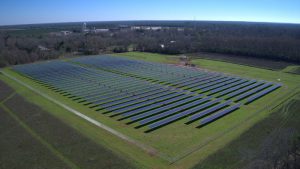According to a February article in the Atlanta Business Chronicle, Georgia is the third fastest solar-power producer in the US. Georgia solar jobs grew by 23% over 2015. In addition to the solar panels you might put on your house, however, Yale Environment 360 says that large-scale solar power production is growing across the country in https://e360.yale.edu/features/northern-lights-utility-scale-solar-power-spreading-across-the-us, and some installations are starting to be put in the Southeast as well.
While solar power is becoming more competitive with other forms of energy, however, these large-scale installations are bringing some controversy. According to the Wall Street Journal (https://www.wsj.com/articles/solar-energys-growth-sows-concerns-over-farmland-1488991708, unfortunately behind a paywall) and the Connecticut Mirror at https://ctmirror.org/2017/02/21/new-farmland-harvest-solar-energy-creating-political-sparks/, some folks are torn between using prime farmland for solar installations while other farmers want the ability to earn more money with solar power than they could with traditional agriculture.
Agricultural producers may find some advantages to using solar power on their farms, for example in running pumps in remote locations. The USDA published a long report in 2011 which describes the uses of solar power on farms at https://www.usda.gov/oce/reports/energy/Web_SolarEnergy_combined.pdf. Keep in mind that as the cost of solar power continues to drop, it may become more economically viable for farmers to use in the future.
